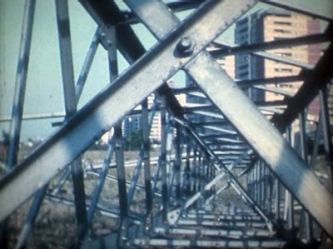Igor Toholj’s (b. 1968) Death of Metalosaurus is a short film that its creator made after seeing an electricity pylon laying on the ground in a field near Blok 45, a section of the New Belgrade suburb of Belgrade. The strangeness of the sight inspired Toholj to film it, and he intuitively saw the pylon as a giant beast or, as the film’s title suggests, the skeletal remains of an enormous dinosaur, which he captured through a series of rapidly alternating close-ups shot from a variety of angles. As Toholj explains, initially, the “impulse for shooting was enough, without preparation or research process. . . . I [passed] by this site very often in those days, riding on a tram.” In considering his footage, however, Toholj later saw its allegorical potential, which is why the title and opening credits of the film were written on a blank form with a red star that was normally used for obituaries in socialist Yugoslavia. Combined with its title, the film thus captured presciently its maker’s feeling that he was living through the collapse of Yugoslavia and the “death” of the “mastodon” of the old political system.[1]
Banner stills L to R: Litany of Happy People, courtesy Slovene Cinematheque;
Death of Metalosaurus, courtesy Igor Toholj; and Game, courtesy Slovene Cinematheque
Death of Metalosaurus (Smrt metalosaurusa)
Igor Toholj, Serbia, 1989, Super 8 transfer to Blu-ray, 3 minutes

Still from Death of Metalosaurus, courtesy Igor Toholj
As formal inspirations, Toholj cites “constructivism and industrial music.” Indeed, the film’s abstract views of the pylon’s geometric forms hark back to iconic images of early 20th-century radio towers made by such artists as Mikhail Rodchenko and Laszlo Moholy-Nagy. Yet the film adds a touch of surreality in showing the pylon as a fallen giant on its side, and this feeling is heightened through the use of pixilation and shooting with a reduced frame rate. These techniques, Toholj notes, were “powerful [tools for] transfer[ing] this feeling . . . I had while approaching [a] metal mastodon, becoming part of [a] network of geometrically shaped metal bars within it. [The] staccato rhythm of [the] shots [created the] visual equivalent [of] this strange yet unforgettable installation.” The staccato rhythm of the jump cuts also draws on the montage techniques developed in the early 20th century in Hollywood by the Serbian avant-garde filmmaker Slavko Vorkapić, who also influenced Dušan Makavejev and who himself drew on the phi phenomenon to create an illusion of movement out of rapidly changing still images. The film’s sound also adds to the film’s nervous energy—it consists of unusual noises 10 seconds of which Toholj sampled on a synthesizer and then repeated at different speeds to the rhythm of the images.
Like many of his peers across Eastern Europe and beyond, Toholj created his amateur experimental films largely for the love of art. His intended audience consisted primarily of fellow avant-gardists in late 1980s Belgrade, though Toholj did receive an award for this film at the UNICA 1989 World Amateur Film Festival in Baden Baden, Germany. More recently, in the 2000s, it has also been shown in programs of the Alternative Film Festival in Belgrade and during the retrospective titled 50 years of the Academic Film Center (2008). Like a number of amateur film club members from the former Yugoslavia, Toholj eventually turned his passion into a profession and currently works as a film editor, director, and producer in Belgrade. He is also active as the editor of the Film Program at the Student City Cultural Center in Belgrade (the organization that today houses the amateur film club of which he was an erstwhile member).

Still from Death of Metalosaurus, courtesy Igor Toholj
In historic perspective, his film also offers an interesting, if highly idiosyncratic, look at New Belgrade’s “Blocks,” which since the collapse of Yugoslavia in 1991 have not always been seen in a positive light—their most famous cinematic representation outside Serbia was in the French action film District 13: Ultimatum (2009), where they were shown as a troubled suburb of Paris in a dystopian future. In Toholj’s film, one also perceives the neighborhood’s unusualness, but what strikes one here is its semiurban character rather than its grit—from certain angles, the pylon seems to lie somewhere at the edge of human habitation, where nature meets the city and is taking over its technological advances.[2] Yet the city is sunny, clean, spacious, and welcoming, if somewhat visually monotonous, and it defies the familiar stereotype of bleakly gray sleeper suburbs associated in the popular imagination with postwar urbanization in the socialist bloc. — Ksenya Gurshtein
With thanks to Igor Toholj and Miodrag Milošević, Head of the Academic Film Center at the Student City Cultural Center (Akademski Filmski Centar Dom Kulture Studentski Grad), Belgrade, and to the entire staff of the AFC for their assistance with research and help in making a screening of this film possible in Washington. With special thanks also to the Film Center Serbia (Filmski Centar Srbije), Belgrade, which generously sponsored the digital restoration of this film shortly before its screening in Washington.
1. Unless otherwise noted, the information about the film comes from the author’s e-mail correspondence with Igor Toholj in April 2014. (back to top)
2. In reality, the neighborhood around the pylon is well developed but has large swaths of green space. (back to top)
